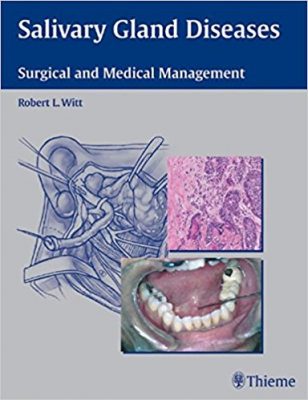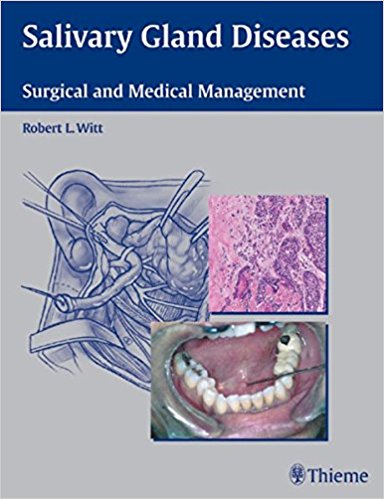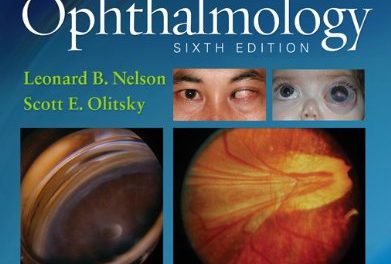 Editor: Robert L. Witt, MD
Editor: Robert L. Witt, MD
Publisher: Thieme – 272 pages
Book Review by: Nano Khilnani
Diseases and disorders of the salivary glands are clinico-pathologic conditions that are developmental, reactive, or inflammatory in nature, states Dr. Randal S. Weber, the Foreword writer of this book, who is the Herbert L. and Oliver Stringer Distinguished Professor and Chairman of the Department of Head and Neck Surgery at the University of Texas M.D. Anderson Cancer Center.
Some of these conditions are benign, while others are malignant (cancerous). There are many kinds of salivary gland cancers, but their occurrence is very rare – only one person among 100,000 people is afflicted with them. These malignancies are covered in chapter 10 of this book entitled Malignant Neoplasms of the Salivary Glands.
We mention this chapter – and are providing a list of salivary gland cancers below – at the beginning of this book review because it is important for those who deal with salivary gland diseases to know which ones are malignant and therefore most important to learn about how to precisely deal with them in an effective manner.
These cancers are listed and are discussed (including their clinical presentation, genetics, histology, imaging, pathogenesis, staging, and treatment) beginning on page 147 under the heading Epithelial-derived Salivary Gland Malignancies:
- Mucoepidermoid Carcinoma
- Adenoid Cystic Carcinoma
- Acinic Cell Carcinoma
- Basal Cell Salivary Adenocarcinoma
- Myoepithelial Carcinomas
- Salivary Clear Cell Carcinomas
- Epithelial-Myoepithelial Carcinoma
- Clear Cell Carcinoma
- Salivary Duct Carcinoma
- Terminal Duct (or Polymorphous Low-Grade) Adenocarcinoma
- Unclassified Adenocarcinoma
There are three other cancers discussed in this important chapter 10 named under the heading
Epithelial-Mesenchymal-derived Salivary Gland Malignancies and these are:
- Carcinoma Ex-Pleomorphic Adenoma
- Carcinosarcoma
- Metastasizing Pleomorphic Adenoma
Lastly, there are also mesenchymal-derived salivary malignancies, and these are discussed at the end of this chapter.
Another important chapter in this book is No.7 – Classical Approaches to Sialoendoscopy for Treatment of Sialolithisiasis. Obstructive sialodenitis, with or without sialolithiasis, is the main inflammatory disorder of the major salivary glands (affecting mostly adults), writes the chapter author Oded Nahlieli. Sialolithiasis is a common finding accounting for about 50 percent of major salivary gland disease, and the submandibular gland is the most prone to sialolithiasis.
Sialoliths are essentially ‘stones” that vary in size, shape, texture and consistency that create inflammations and obstructions. But diagnosis and treatment of obstructions and inflammations caused by this disease is difficult to image with standard techniques, particularly to find their precise locations.
While studies have found that 80 percent of sialolithiasis cases are found in the submandibular glands, 19 percent are in the parotid gland and a tiny one percent are in the sublingual gland. Until recently, the main treatment option was complete removal of the glands under general anesthesia, but that is changing with better imaging technology having come to the fore.
This book on the many kinds of salivary gland diseases is the work of Dr. Robert L. Witt, as well as 32 specialists in otolaryngology, otorhinolaryngology, head and neck oncology, head and neck surgery, oral and maxillofacial surgery, pathology, and pediatrics. They authored the 17 chapters of this book. We list them below to provide you an overview of its coverage. All of the contributors are from the United States, except two, who are from England and Israel.
- Salivary Gland Anatomy
- Imaging of the Salivary Glands
- Embryology, Physiology, and Biochemistry of the Salivary Glands
- Histology, Epithelial Metaplasias, Noninflammatory and Non-neoplastic Lesions of the Salivary Glands
- Sialadenitis
- Histology and Pathology of Sialadenitis
- Classic Approaches to Sialaendoscopy for Treatment of Sialolithiasis
- Pediatric Salivary Gland Disease
- Benign Tumors, Cysts and Tumor-like Conditions of the Salivary Glands
- Malignant Neoplasms of the Salivary Glands
- Metastasis to Major Salivary Glands
- Treatment of Salivary Lymphoma and Advanced Nonlymphoid Malignant Salivary Gland Neoplasms
- Advances in Radiation Therapy for Salivary Gland Neoplasms
- Etiology, Pathogenesis, and Treatment of Radiation-induced Xerostomia
- Atlas of Salivary Gland Surgery
- Facial Paralysis Rehabilitation
- Medicolegal Perspectives in Salivary Gland Diseases
The editor Dr. Witt writes that this book “includes complete coverage of current didactic information in the field, surgical treatment chapters with illustrations of basic and advanced surgical procedures and extensive color histologic, pathologic, and cytologic photomicrographs.”
Besides the micrographs, other types of images – such as anatomical sketches, charts, computed tomography (CT) scans, endoscopic views, fine-line drawings, photos of instruments (e.g. sialoendoscope) and patients with benign and malignant cysts and tumors, radiographs and tables with data – are provided in this book that enable you the reader to acquire a better understanding of the various diseases and their progression.
This is an excellent volume on salivary gland disease, a subject on which few books are available, so that make it even more important for those practicing in this specialty.
Editor:
Robert L. Witt, MD is Chief of Otolaryngology – Head and Neck Surgery – at Christiana Care Health System (CCHS) in Wilmington, Delaware, Chief of Head and Neck Oncology at Helen F. Graham Cancer Center at CCHS in Newark, Delaware, and Assistant Professor at Jefferson Medical College in Philadelphia, Pennsylvania.







